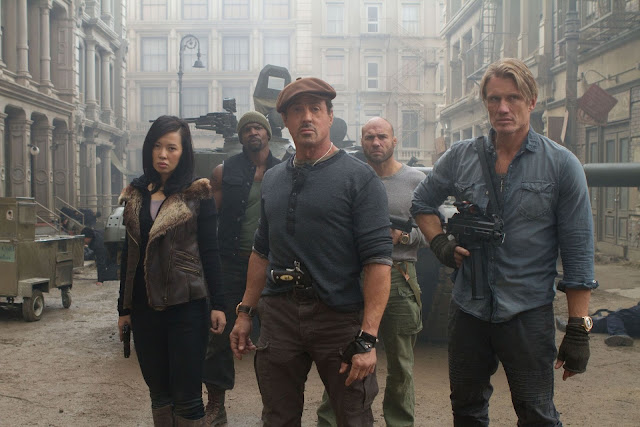 |
| Still from The Expendables 2 [source] |
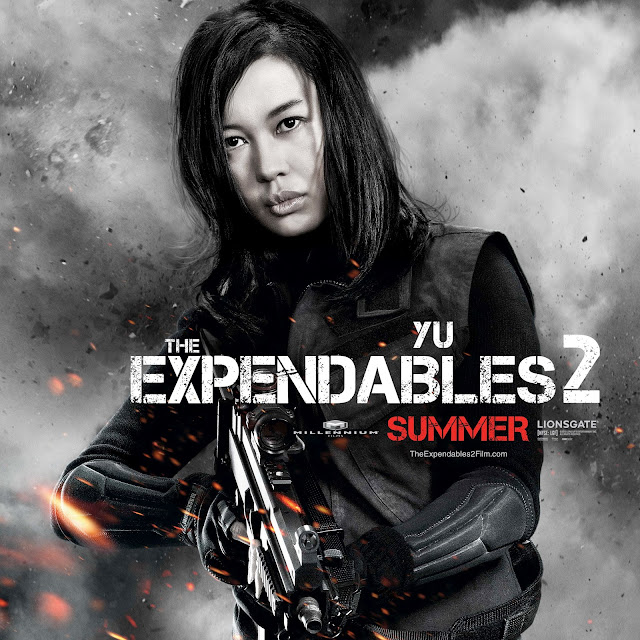 |
| Promotion poster for The Expendables 2 featuring Nan Yu |
The radical notion that women like good movies
 |
| Still from The Expendables 2 [source] |
 |
| Promotion poster for The Expendables 2 featuring Nan Yu |
Sexism isn’t something that is over. And if we look at contemporary media, we see it there as well. Disney movies didn’t stop featuring childish and passive female characters after Roe v. Wade. Romantic comedies didn’t stop perpetuating the notion that women need to be saved from themselves by a man. Women haven’t stopped being portrayed as sexual conquests in action flicks.
 |
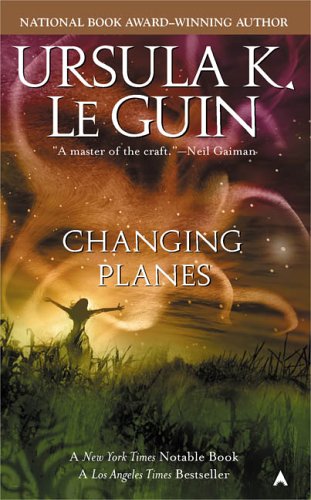 |
Guest post written by Carissa Harwood.
Admittedly, Avatar isn’t my thing, I’m not big on James Cameron or any alien films (not only his), I’ve never been interested in Star Wars or Star Trek (though I have seen enough of both franchises to hold a conversation), so I wasn’t planning on watching Avatar at any point in my life. However, this afternoon, I changed my mind when a free screening became available to me. With my original plans canceled and a spare two and a half hours available, I tucked into James Cameron’s latest film.
Well, Avatar wasn’t what I thought it would be, but it wasn’t any better. I spent most of the first half of the movie developing alternate titles ending with “in space.” “Pocahontas in Space,” “Dances with Wolves in Space,” and “Titanic in Space” all sprang to mind. For the most part, it seems Cameron has taken plots from various other films, thrown them together, dyed it blue, and placed it on the fictitious planet, Pandora, to create a science-fiction retelling of the Pocahontas mythos.
[…]
As much as I would like to sit through a movie like this and enjoy it for what it is (ground-breaking sci-fi entertainment that will go down in history), I simply can’t. James Cameron’s attempt to create a more spiritual, natural, and peaceful society leaves me annoyed that once again this idea is filtered through a white, Western, male member of a patriarchal society. Some theorists will consider Cameron’s Alien trilogy feminist, because of Sigourney Weaver’s empowered Ripley (legend says it was written to be asexual–with casting deciding the character’s sex), but she still has to prove her femininity and womanliness by saving cats and small children. I fear that many feminists will laud Avatar as well–for creating a world where the people worship a female entity (“Eywa”), because the Clan leader’s female mate/wife is as powerful as him, and since the female lead is as empowered as Ripley. However, like Ripley, Neytiri too has her feminine trappings, as her power can be explained away through her heritage.
I have a confession to make. I’m a big softie when it comes to movies. I shed tears at the drop of a hat. But I usually don’t cry during a film trailer. But Beasts of the Southern Wild — both the trailer and the film itself — made me weep.
A strange, haunting, breathtaking dystopian fantasy — it contends with polar ice caps melting, prehistoric creatures, lands flooding, and the bonds of family. With its lush scenes, poignant and complex characters, and achingly beautiful music, it stirred emotions and memories long forgotten. It’s a triumph of the human spirit. And the best part? At the bittersweet film’s center is a little girl.
The film’s female protagonist is Hushpuppy, a 6-year-old African American girl who lives with her father on an island called the Bathtub. And she is a breath of fresh air. Played with depth, nuance and sensitivity, newcomer Quvenzhané Wallis — who’s already generating lots of Oscar buzz — dazzles on-screen. Her luminous personality captivating you at every moment. She’s been called “a miniature force of nature.” And I couldn’t think of a more perfect description. It’s hard to believe Wallis was only 5 years old when she filmed the movie.
Hushpuppy is a pint-sized powerhouse. An indomitable survivor. She’s brave, tough and strong-willed. There’s a fierce intensity, and an old wisdom behind her eyes. Honest, vulnerable and sweet – she is the film’s moral compass, its anchor.
Too often with films with daughters, they merely exist so we can see how the parents react to them. But here, we witness the story unfold from Hushpuppy’s perspective. Director and co-screenwriter Benh Zeitlin said he made a conscious decision to only yield information Hushpuppy has access to. We the audience see only what she sees. She narrates the film throughout so we always know her thoughts and feelings. But honestly, even if you erased all the narration, you would still know because of Wallis’ expressive face and body language. Through her narration, we peek a glimpse into her psyche. Hushpuppy utters poetic and sage musings:
“When it all goes quiet behind my eyes, I see everything that made me flying around in invisible pieces… Everybody loses the thing that made them. The brave men stay and watch it happen. They don’t run.”
“I see that I am a little piece of a big, big universe, and that makes it right.”
Hushpuppy frequently lets out this little scream that reminds me of a warrior cry akin to Xena. It’s as if she’s declaring, “I’m here world. Deal with it.” She carries the weight of the world on her shoulders. Yet there’s a buoyancy to her spirit. Putting animals up to her ear so she can “listen to their innermost desires,” savoring each bite of food she eats…these bring her joyous rapture. Hushpuppy is the film’s moral compass and anchor. We see the whole world through her eyes.
While at times it looks the same, the world in Beasts of the Southern Wild is not ours. The Bathtub was inspired by the real Louisiana island Isle de Jean Charles, which is frequently flooded and is “cut off from the levee system.” Beneath the surface of this strange fantasy, it feels like an allegory of Hurricane Katrina. Although director and screenwriter Zeitlin insists the film is not about Katrina. An apocalyptic fantasy grounded in realism, Zeitlin discussed the film’s message:
“It’s a folk tale about the emotional experience of what it’s like to have to survive the end of your world, and to lose the things that made you.”
Despite his protestations, the parallels between Beasts of the Southern Wild and Hurricane Katrina are uncanny. The film contends with how to survive losing your home amongst horrific destruction and how we shouldn’t turn our back on people. Again feeling like a parallel to the way the government turned its back on Katrina survivors, particularly the survivors of color. The film also contains a strong message of environmentalism. If we continue down the same path of environmental degradation, we may destroy the planet. The philosophy that we are all connected reverberates throughout the film. Especially when Hushpuppy says:
“The whole universe depends on everything fitting together just right. If one piece busts, even the smallest piece…the entire universe will get busted.”
Beasts of the Southern Wild features a disturbing yet loving relationship between Hushpuppy and her ailing father Wink (Dwight Henry), an alcoholic, who vacillates between joyful hope and pained anger. In the beginning, he’s cold and cruel, alcohol warping his lucidity and judgment. He knows he has to take care of her and teach her how to survive in the world. But he seems to resent it as he can barely take care of himself. We eventually see his benevolent streak as he looks for survivors. By the end of the film, I broke down in silent sobs as we witness the strength of their bond.
Too often in film and TV, black fathers are absent, either dead or incarcerated. So it was great that here was a black father. And Henry imbued depth, anger, pain and hope into his character. But why did he have to be so broken? Why can’t we see a positive representation of a black father?
Like many fantasies and fairy tales, we witness an absent mother. But Hushpuppy’s mother’s presence is very much alive. Hushpuppy carries around a sports jersey, a symbol of her mother. She has imaginary conversations with her mother. When she sees a blinking beacon off on the horizon, she believes it’s her mother beckoning her. We also see a maternal figure in Miss Bathsheeba (Gina Montana) who nurtures and cares for all the children of the Bathtub. As her world begins to crumble, Hushpuppy eventually goes in search of her mother. In her journey, Hushpuppy traverses the land with three young girls at her side.
The film boasts strong, resilient, outspoken women and girls. And the stereotypically feminine trait of caretaking is lauded and celebrated. Miss Bathsheeba tells the children that they’ve got to take care for those “littler and sweeter than them…that’s the most important lesson I can teach you.” Wink believes it’s his duty and responsibility to teach his daughter how to survive and take care of herself. Screenwriter Lucy Alibar said he ultimately teaches Hushpuppy:
“How to take care of people. How to take care of someone weaker than you. The strength of kindness. The strength of standing with some place, with your family.”
Sadly, through gendered language, the feminine is often denigrated and demeaned at worst and diminished at best.
Wink often says “man” to Hushpuppy, like “Hey, man.” When they arm wrestle he asks her, “Who’s the man?” To which she proudly replies, “I’m the man.” When Hushpuppy’s house is destroyed – yes, her and her father each have their own house with their own belongings – he draws a line separating Hushpuppy from his sphere, the masculine one. He tells her that no girly toys are allowed on his side, but that he can’t hit her on her own side, something in her favor (Um, what?? Yeah, I’m not cool with violence). Wink often tells Hushpuppy, “No crying,” not allowing her emotions that depict weakness in his eyes. Even when we’re introduced to Miss Bathsheeba (Gina Watson), she’s telling the children not to be “pussies,” something uttered by Hushpuppy herself later in the film.
Food plays an integral role in the film, as sustenance, as a part of culture and as celebration. You see Hushpuppy, her father and their community eating seafood. While it was difficult for me to watch as a vegan, the feminist in me was thrilled that we see a girl eat. In reality, women and girls obviously eat. Due to the media’s policing of female bodies, women and girls have an antagonistic relationship to food. We don’t typically see female characters eating on-screen.
We also see a subtle commentary on gender performance and gender norms. When the residents of the Bathtub are transported to the mainland by the government, Hushpuppy is forced to wear a frilly, girlie-girl dress and tame her wild hair. Stripped of her identity and forced into conformity, she looks miserable. She doesn’t want to be constrained in gender stereotypes. Unconsciously, she wants to perform gender on her terms, not society’s.
I often lament the lack of female-centric films, particularly with women and girls of color. When we do see women, they usually appear as sidekicks or love interests to men. But not here. A black girl is front and center. And even though the film focuses on Hushpuppy’s relationship with her father, her relationship with her mother is equally as important.
We often see boys and men in films that showcase a hero’s journey or transformation. But here – in this film showcasing a triumph of the spirit – we see a journey with a strong-willed, opinionated girl of color. And I couldn’t be more thrilled.
Mystical, ethereal, surreal, touching – Beasts of the Southern Wild is all of these and yet so much more. Even as you watch the film, you might not understand or fully comprehend the meaning of the unusual plot. But let its poetic beauty, emotions and raw honesty wash over you. Let it sink in. For it will be a long time before another film like it – or another female hero as complex as Hushpuppy – comes our way.
 |
| Mia Wasikowska and Glenn Close in ‘Albert Nobbs’ |
Haunting and sad, Albert Nobbs tells the tale of a woman who disguises herself as a man in order to survive in 19th Century Ireland. A “labor of love” and a “dream fulfilled,” Oscar nominee Glenn Close, who co-wrote the screenplay, tried to get Albert Nobbs made into a film for 30 years. Adapted from the play, which Close starred in on Broadway in 1982, is itself adapted from George Moore’s short story. Moore’s books were controversial “because of his willingness to tackle such issues as prostitution, extramarital sex and lesbianism.” Rodrigo Garcia’s poignant film Nine Lives, which Close also appeared in, showcasing 9 vignettes of women’s lives, is one of my favorite films. So my expectations were high for Albert Nobbs.
Was this a “jaw-dropping performance” by Glenn Close? She was absolutely outstanding. I didn’t realize at first just how good of a job she did until I realized I completely forgot that it was Glenn Close! I’m used to seeing her play strong, confident or assertive women. Here, Close plays a character shy, awkward, guarded and desperately lonely. She melts into the role. She’s as straight-laced and tightly wound as the prim and proper world around her.
“Albert was particularly tricky because there’s always the question of how much should show on her face because a lot of it is somebody who’s totally shut down, who doesn’t even look people in the eye. Servants weren’t supposed to look people in the eye, but she’s an invisible person in an invisible job. And then her whole evolution is slowly being able to look up – the first time she really looks someone in the face is after she’s told Hubert her story and then she kind of looks out to her dream.”
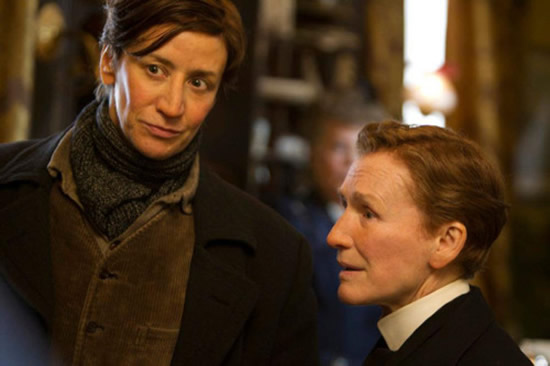 |
| Janet McTeer and Glenn Close |
“I tried to be, on the one hand, very male, by which I mean large and expansive and confident and sitting on the back of the heels, as it were, and on the other hand I wanted [my character] Hubert to have as many as what we consider to be the loveliest of the female qualities — empathy, compassion, kindness. I wanted Hubert to be a really good mixture of both.”
After Albert meets Hubert, she realizes she could have a life of companionship. SPOILER -> Hubert is married to a woman she adores and a beautiful scene between the two portray a tender, loving and devoted couple. <- END SPOILER Hubert gives Albert hope for a different future: a life free from the shackles and confines of loneliness. In a bittersweet scene, Hubert and Albert walk along the beach together. Albert in a dress, the first she’s worn in 30 years, runs along the beach. Reminded of her old identity, in a rare expression of emotion, she’s unconstricted, buoyed by freedom and sheer joy.
Many movies contain cross-dressing plotlines for comedic effect. But not a lot exist that focus on gender-bending from a dramatic angle. Boys Don’t Cry and Transamerica explore the lives of a trans man and woman while Yentl and The Ballad of Little Jo both echo Albert Nobbs as they feature women who choose to live as men in order to survive or pursue their dreams. An act of violence as a young girl catalyzes Albert to live as a man to protect herself and survive.
Critics have focused on the gender components. But class, an equally important theme, threads throughout the entire film. Albert Nobbs depicts how women contended with and endured poverty. We witness the stark dichotomy between the lavishly wealthy clients and the servile wait staff in the hotel. Servants in the Victorian Era were to be invisible, never looking the upper class in the eye. With her downcast eyes, Albert remains dutiful. Yet she begins to aspire for more. Albert has been saving her money all her life and hopes to open a shop of her own.
The film portrays relationships and courtship as an economic contract. When Albert courts the coquettish Helen (Wasikowska), Helen expects and asks for all sorts of gifts and trinkets. SPOILER -> We also see class play out after Helen gets pregnant. Women needed men in order to survive financially. Women who give birth to children out of wedlock were punished fiscally, fired from their jobs. Husbands provided fiscal security. <- END SPOILER Gender and class coalesce. You realize Helen’s gender and station in life condemn her situation. Albert and Hubert would never be able to attain their dreams (and Hubert her independence) had they retained their identity as women.
I perpetually worry audiences watch period films with dangerously confining gender roles and then sit back thinking, “Phew, we’ve come so far!” Yeah, no, we so haven’t. Albert Nobbs raises so many thought-provoking questions. Why is the male gender the more “desirable” gender in society? What does it say about a society where half its population has a mere two options for their lives? How can women take charge of their own lives amidst confining gender norms? But therein lies my problem with the film. It provides no conclusions, the answers remain elusive.
The tragic story of Albert Nobbs lingered in my memory long after I left the theatre. Its exploration of female friendship, lesbian love, class and poverty, gender roles and a woman’s self-discovery, truly make it a rare gem.
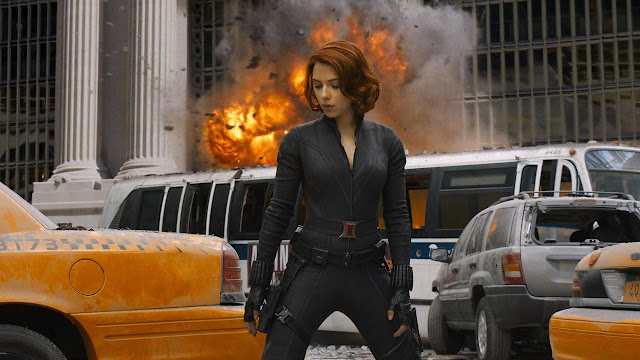 |
| Natasha Romanoff / Black Widow (Scarlett Johansson) in The Avengers |
Smashing box office records, audiences have been swept up in The Avengers hullabaloo. Interesting and compelling, the epic superhero film based on the Marvel comics unites Black Widow, Captain America, Iron Man, Hawkeye, the Hulk and Thor “to form a team that must stop Thor’s brother Loki from enslaving the human race.” It was good. Really good. It contained complex characters and funny, clever dialogue. In a genre that exhibits strong female characters yet often objectifies women’s bodies or reduces them to ancillary love interests…how was The Avengers’ portrayal of women?
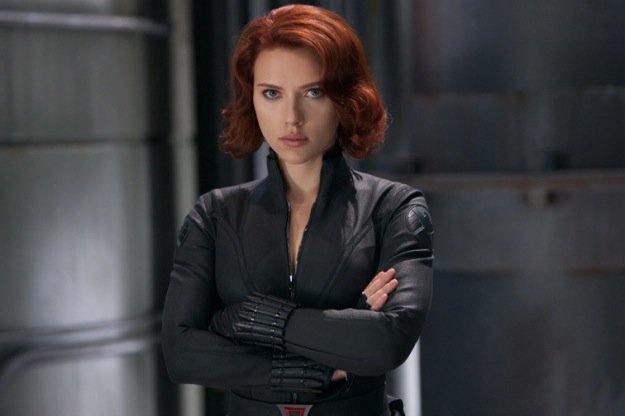 |
| Black Widow / Natasha Romanoff |
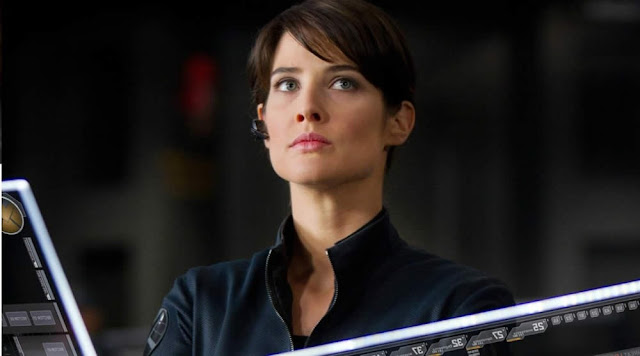 |
| S.H.I.E.L.D. Agent Maria Hill (Cobie Smulders) |
AlterNet’s Julianne Escobedo Shepherd thinks The Avengers possesses a “stark feminist perspective” as it differs from so many other superhero films. Even in movies with multiple female characters like X-Men, the women often orbit the male characters. Not so in The Avengers. Escobedo Shepherd goes further asserting Johansson portrays Black Widow’s “talent for manipulation as a boon for the art of spying, rather than any kind of femme fatale cliché.”
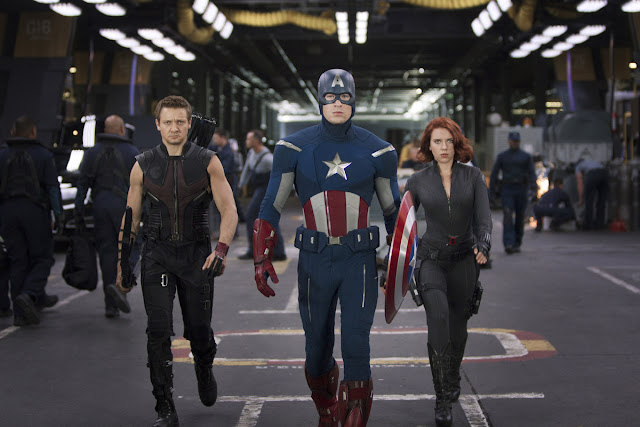 |
| (L-R): Hawkeye (Jeremy Renner), Captain America (Chris Evans), Black Widow (Scarlett Johansson) |
 |
| Kirsten Dunst in Sofia Coppola’s Marie Antoinette |
Amber‘s Picks:
How Twitter Reflects the Themes of Our Society from The Nerdy Feminist
The Future of Feminism series from Fourth Wave
Vogue Italia’s “Haute Mess”: Racist, Ignorant, or Brilliant? from Racialicious
Spotlight: Anna and Modern-Day Slavery from Her Film
Sympathy for the Devil: On HBO’s Game Change, and Hating Ladies for the Right Reasons from Tiger Beatdown
Capitol Control: The Irony of The Hunger Games Movie Mania from Bitch
Stephanie‘s Picks:
“BYT @ SXSW Movies: Wonder Women“ by Jeff Spross for Brightest Young Things
“Tavi Gevinson on Creativity, Taste, and the Word ‘Girly'” from Huffington Post
“Hungering for a Female Hero: Hunger Games May Break New Ground” by Tom Long for Detroit News
“The Bitch List: Does Your Screenplay Have What It Takes?”
“On Feminism: Romantic Femininity” by Hila Shachar for Le Projet D’amour
Megan‘s Picks:
It’s Women’s History Month! Celebrate by Seeing The Hunger Games and Vote with Your Dollars This Weekend via I Will Not Diet
Will the Box Office Change the Gender Balance in Film? via Feminema
Mad Men: Set Me Free – a musical mash-up with the series’ female characters via Pop Culture Pirate
Steel Magnolias Remake Cast Announced: Queen Latifah, Phylicia Rashad to Star via Clutch Magazine
The Feminist Harry Potter Tumblr You’ve Been Waiting For via Bust Magazine
Leave your links in the comments!
 |
| Marion Cotillard and Owen Wilson in ‘Midnight in Paris’ |
In Allen’s latest Oscar-nominated endeavor, Midnight in Paris, Gil Pender (Owen Wilson) is a successful Hollywood screenwriter struggling to write his first novel. He visits Paris with his constantly complaining fiancé Inez (Rachel McAdams), as he yearns to live amongst his literary idols in the Roaring Twenties. Gil discovers that at midnight, he is able to transport to 1920s Paris and hobnob with writers, musicians and painters. A love letter to Paris and artists, Midnight in Paris explores the dichotomy between illusions of nostalgia and pragmatically embracing the present.
Allen has a knack for evoking the visceral beauty of a city: NYC in Annie Hall and Manhattan, Barcelona in Vicky Cristina Barcelona, Paris in Midnight in Paris. With lush cinematography, Allen capturesthe seductive allure and breathtaking romance of Paris. He also infuses the film with myriad authors and artists from the 1920s, a bibliophile’s dream. These delightful distractions almost made me forget (almost) that while an okay film, it’s certainly not a great one.
Now, I didn’t hate Midnight in Paris like my kick-ass colleague Stephanie. But I totally understand why she did because it royally pissed me off too. The portrayal of women in this film is fucking problematic.
Kathy Bates is fantastic as writer and art collector Gertrude Stein. Yet she’s highly underutilized, striving to make the most of her small role. Incredibly influential, we witness Stein’s Parisian salon which attracted talented writers, like Ernest Hemingway and Ezra Pound, whom she advised and mentored. After reviewing his manuscript, Gertrude bestows Gil with her wisdom: “We all fear death and question our place in the word. The artist’s job is not to succumb to despair but to find an antidote for the emptiness of existence.” Aside from Gertrude, none of the female characters are either truly likeable, interesting or complex individuals.
Audacious Zelda Fitzgerald (Alison Pill, who tries her best to imbue her with charm), F. Scott Fitzgerald (Tom Hiddleston)’s wife and a writer in her own right, diminishes her artistic talent by saying, “…and I realize I’ll never write a great lyric and my talent really lies in drinking.”
An “art groupie” muse, Adriana (Marion Cotillard) designs couture fashion and becomes the object of Gil’s affection, despite his fiancé. When Gertrude reads the first line of Gil’s book aloud, Adriana praises it saying she’s “hooked” and later calls his musings on the “City of Light” poetic. Enamored with her, they begin to spend their evenings talking and walking around Paris. Cotillard is a divine actor. But her character is beige and boring. Although I must admit I’m glad Adriana ultimately chooses her own path.
In addition to seeking Stein’s advice on his book, Gil turns to another woman, an art museum guide (Carla Bruni), for advice on being in love with two women at the same time. Oh, and he also flirts with 25-year-old Gabrielle (Léa Seydoux) (cause you know, that’s what middle-aged dudes do) who sells old records from the Jazz Age and shares his love of Paris in the rain.
 |
| Owen Wilson and Rachel McAdams in ‘Midnight in Paris’ |
Now, I don’t automatically have a problem with a villainous or unlikeable female character, especially since there are so many female roles in the film. In fact, I often lament how unlike men, women are not allowed to play unlikeable or unsympathetic characters. But I have a huge problem with the “nag” role. The cliché of women as “nags” permeates pop culture.
I also have a huge problem that the seemingly sole reason Inez was made so horribly despicable was to “allow” Gil to cheat on his fiancé. The audience would sympathize with Gil for kissing another woman, buying her trinkets, baring his soul to her and planning to sleep with her even though he was engaged because his fiancé was such a shrew. Oh that’s right, I forgot! It’s okay to cheat on someone as long as they’re an asshole.
Allen told Rachel McAdams that she should play this role as she should “want to play some bitchy parts” as they’re more interesting. Maybe. But not this part. I didn’t find her character interesting at all. Yes, McAdams tries her best with the material she’s given. But the character is one-dimensional and annoying, lacking any depth or complexity.
Midnight in Paris, like pretty much all of Allen’s films, lacks diversity. They’re a sea of white with no people of color anywhere in sight. Oh I take that back. There’s a black woman in a car that Gil gets in on his “way” to the 1920s, one shot of Josephine Baker (Sonia Rolland) dancing that lasts all of 30 seconds and a few black people watching her dance.
Along with race, sexual identities are also omitted. The film contains three famous lesbians: Gertrude Stein, Stein’s life partner Alice B. Toklas (Thérèse Bourou-Rubinsztein) and writer Djuna Barnes (Emmanuelle Uzan). Of all three, Gil only alludes to Djuna’s sexuality when he says she led when they danced together. So lesbianism is almost completely erased, paving the way for good ole’ heteronormativity.
The only overt gender commentary occurs when Ernest Hemingway (Corey Stoll) says, “Pablo Picasso thinks women are only to sleep with or to paint,” but he believes “a woman is equal to a man in courage.” Which is interesting since Allen is a person who in his personal life doesn’t always believe equality in relationships is desirable: “Sometimes equality in a relationship is great, sometimes inequality makes it work.” (???) Yeah, this explains a lot. He also has a penchant for younger women, in his movies and in reality, because younger women are more innocent, “before they get spoiled by the world.” Gag.
I swear people nominated Midnight in Paris for so many awards because Hollywood is lazy. Rather than nominating ground-breaking, intelligent films like Pariah, The Whistleblower or Young Adult, this gets nominated because Allen is a famous, old, white male director. Good job, Hollywood. Way to keep perpetuating the dude machine.
The film suffers from a major woman problem. The women in the film are just as intelligent and talented as their male contemporaries. Gil turns to women for advice and guidance. Yet Allen reduces almost all of them to love interests and arm candy, nothing more than satellites to a dude.
Luckily, Season 2 will see an influx of new characters, including lots of female roles. Huzzah! The “Red Priestess” Melisandre of Asshai (Carice van Houten), female warrior (!!!!) Brienne of Tarth (Gwendoline Christie), noblewoman Lady Margaery Tyrell (Natalie Dormer), Ygritte (Rose Leslie), the Ironborn captain (double !!!!) Yara Greyjoy (Gemma Whelan) named “Asha” in the novels. Wait, a sorceress, warrior and ship captain?? More women in leadership roles?? Sounds promising!
“Three great men: a king, a priest and a rich man. Between them stands a common sell sword. Each great man bids the sell sword kills the other two. Who lives? Who dies? Power resides where men believe it resides. It’s a trick, a shadow on the wall. A very small man can cast a very large shadow.”
“I am Daenerys Stormborn and I will take what is mine with fire and blood.”
“Anyone can be killed.”
“Throughout the first season…women are raped, beaten, burned and trafficked. I suppose you could chalk it up to the barbarism of medieval times. And I’m sure many will claim that as the show’s defense…or that the men face just as brutal and severe a life. I also recognize that there’s a difference between displaying sexism because it’s the time period and condoning said sexism.
“But this IS a fantasy, not history, meaning the writers can imagine any world they wish to create. So why imagine a misogynistic one?”
“I want to read more fantasy. Really, I do. But I’m unable to read it when women are constantly oppressed and seen as lesser beings in a world based on fantasy. Writers, you can create a world with any rules you choose. Yet, you continue to write sexist worlds to have your characters overcome the sexism. Can a girl fight monsters without having to deal with sexism? Does every girl have to disguise herself as a boy to fight in a war? This has nothing to do with cultural or social constructs. In your world, you don’t have to have those.”
Game of Thrones Season 2 airs Sunday, April 1st at 9pm, EST on HBO.